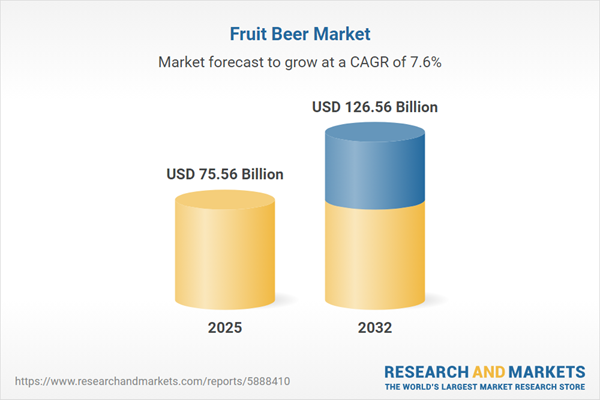Speak directly to the analyst to clarify any post sales queries you may have.
The fruit beer market is experiencing robust transformation, shaped by changing consumer preferences, innovation in flavor profiles, and increased focus on sustainable, responsible production. Senior leaders in the beverage and retail sectors face critical decisions as the marketplace becomes more dynamic, competitive, and strategically segmented.
Market Snapshot
The fruit beer market grew from USD 70.18 billion in 2024 to USD 75.56 billion in 2025. It is projected to continue expanding at a compound annual growth rate (CAGR) of 7.64%, anticipating a market value of USD 126.56 billion by 2032. Growth is propelled by evolving consumer behavior, health and wellness priorities, and a heightened preference for unique taste experiences. This climate has intensified innovation and competition, with both established brewers and emerging brands adapting quickly to shifting demand and regulatory factors.
Scope & Segmentation
- Flavor: Berry (blueberry, raspberry, strawberry), Citrus (grapefruit, lemon, orange), Sour, Stone Fruit, Tropical
- Packaging Type: Bottles, Cans, Kegs
- Alcohol Content: High, Low, Standard
- Age Group: 21–30, 31–45, 46+
- Distribution Channel: Off-Trade (convenience stores, supermarkets), On-Trade (bars & pubs, restaurants)
- Region: Americas (United States, Canada, Mexico, Brazil, Argentina, Chile, Colombia, Peru), EMEA (United Kingdom, Germany, France, Russia, Italy, Spain, Netherlands, Sweden, Poland, Switzerland, United Arab Emirates, Saudi Arabia, Qatar, Turkey, Israel, South Africa, Nigeria, Egypt, Kenya), Asia-Pacific (China, India, Japan, Australia, South Korea, Indonesia, Thailand, Malaysia, Singapore, Taiwan)
- Notable Companies: Anheuser-Busch InBev SA/NV, Heineken N.V., Carlsberg A/S, Asahi Group Holdings, Ltd., Molson Coors Beverage Company, Kirin Holdings Company, Limited, Constellation Brands, Inc., The Boston Beer Company, Inc., Duvel Moortgat NV, BrewDog PLC
Key Takeaways
- Emergence of experimental and hybrid flavor profiles is prompting diverse consumer segments to explore new taste experiences.
- Innovation in yeast selection and fermentation processes among craft and global brewers enhances product differentiation and category depth.
- Health and wellness trends are encouraging development of lower-carbohydrate and lower-alcohol offerings, supporting mindful consumption behaviors.
- Strategic partnerships with fruit growers and raw material suppliers are reinforcing supply chain stability and authenticity stories.
- Digital marketing and direct-to-consumer platforms are building stronger engagement and feedback loops between brands and buyers.
- Regional strategies address distinct consumer preferences, regulatory requirements, and pricing expectations to unlock localized growth opportunities.
Tariff Impact on the Fruit Beer Market
Recent tariff adjustments in the United States have influenced importation costs and shifted sourcing strategies. Producers are reevaluating supply chains, with an uptick in local sourcing and renewed supplier contracts to help manage increased input costs. Distributors and retailers are consolidating logistics and revising promotional tactics to maintain competitive positions, while some smaller brewers capitalize on regional partnerships to circumvent tariff pressures. These moves are strengthening supply chain resilience and prompting operational efficiencies sector-wide.
Methodology & Data Sources
This report is based on a multi-layered research approach, combining primary interviews with brewery leaders, ingredient suppliers, and retailers, alongside extensive secondary data review of regulatory filings and market analytics. Quantitative models and scenario planning supported the sensitivity analysis of segmentation and regional factors.
Why This Report Matters
- Informs strategic investment, R&D direction, and marketing initiatives through deep segmentation and regional insight.
- Enables supply chain and sourcing optimization in response to shifting regulatory and tariff environments.
- Supports data-driven decisions for product portfolio expansion, innovation planning, and channel management across diverse markets.
Conclusion
The fruit beer category is advancing through a combination of innovation, strategic alliances, and adaptability to regulatory shifts. Leaders who harness emerging trends and align offerings with segmented demand will drive sustainable growth and maintain market relevance.
Additional Product Information:
- Purchase of this report includes 1 year online access with quarterly updates.
- This report can be updated on request. Please contact our Customer Experience team using the Ask a Question widget on our website.
Table of Contents
3. Executive Summary
4. Market Overview
7. Cumulative Impact of Artificial Intelligence 2025
Companies Mentioned
The companies profiled in this Fruit Beer market report include:- Anheuser-Busch InBev SA/NV
- Heineken N.V.
- Carlsberg A/S
- Asahi Group Holdings, Ltd.
- Molson Coors Beverage Company
- Kirin Holdings Company, Limited
- Constellation Brands, Inc.
- The Boston Beer Company, Inc.
- Duvel Moortgat NV
- BrewDog PLC
Table Information
| Report Attribute | Details |
|---|---|
| No. of Pages | 198 |
| Published | November 2025 |
| Forecast Period | 2025 - 2032 |
| Estimated Market Value ( USD | $ 75.56 Billion |
| Forecasted Market Value ( USD | $ 126.56 Billion |
| Compound Annual Growth Rate | 7.6% |
| Regions Covered | Global |
| No. of Companies Mentioned | 11 |









